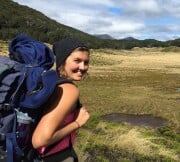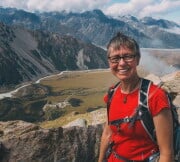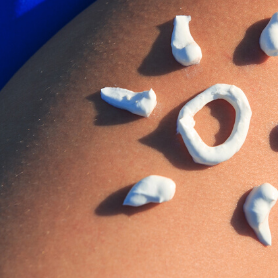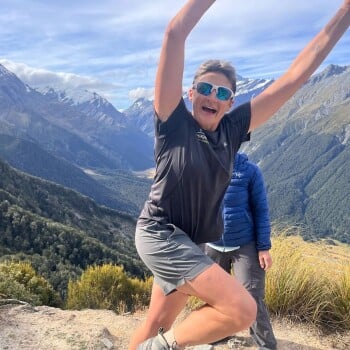- About Us
-
Trips
-
 Kiwi-Style Hiking
Kiwi-Style Hiking
-
 Great Walks
Great Walks
-
 Hiking Tours
Hiking Tours
-
Alpine Hikes
-
Custom Groups
- Huayhuash Trek
- Family Northern Explorer
- Family Southern Explorer
- Lake Waikaremoana Hike
- Women's Custom Tours
- Women's Southern Wilderness
- Coast, Canyons and Mountains
- Coastal Wanderer Custom Tour
- Don't Cross the Ladies
- Secret South Custom Tour
- Tekapo Hike
- West Coast Custom Tour
- World Heritage Custom Tour
-
- Blog
- Shortlist
- About Us
- Trips
- Blog
- Shortlist

Jul 6, 2023
The Chamois buck (or Chammie as us Kiwis like to affectionately call them) eyed us from his high perch next to the nearly frozen waterfall. Maybe he knew we were hikers not hunters because he didn’t look that worried, and watched us for a while. Later he even appeared to be showing off as he leapt from one precipitous-looking ledge to the next as he traversed the craggy slope high above us. More likely he was just terribly confused and upset that he didn’t have any girlfriends. It was breeding season for the Chamois and the young males are known to behave a little strange as rampant hormones surge around their bodies (male readers among us can empathise).
Seeing the Chamois was just one of the delights of guiding a hiking trip on the St James track in the off/winter season. We were also treated to empty huts, stunning vistas of snowcapped mountains, frosty nights, starry skies and when the snow started falling on the last night while we were inside the hut stoking the fire and sipping on steaming cups of milo (New Zealand’s version of hot chocolate), it would have been harder to feel more content.
It would be remiss of me to paint it all as one big glorious picture though. If you are planning on a hike during the winter months in the backcountry of New Zealand there are few things to consider and plan for:
Clothing
Essentially the clothes you take on a summer hike are going to be fairly similar to that you take in the winter – except in the winter you need to take the ‘what ifs’ a bit more seriously and throw in a few extras.
What if I did have to spend the night outside, what if the weather is horrific and I get wet and have to hike for 6 + hours in freezing temperatures, etc .

This is a list of clothing I would take on a multiday hike in the winter, where I would be planning to get above the bushline for a time but not all the time.
Boots and gaiters – dry feet are a nice thing to have when hiking in the winter. Those lightweight hiking shoes that are just great in the summer time probably won’t do much to keep your feet dry and warm after an hour or two of plugging through wet snow, bogs and wet tussock. Your traditional thick leather hiking boots teamed up with a pair of gaiters will help keep your feet dry until you end up in a river up to your knees! If your boots do get wet, putting them somewhere where they won’t freeze overnight is also a great idea.
Raincoat – Goretex type coat that is actually waterproof, not some flimsy single layer thing
Woolen beanie
Poly pro balaclava
Fleece gloves
Gauntlets/Over mitts - waterproof
Macpac Pulsar jacket – this is a favourite of mine, lightweight, warm and even a little waterproof. I use it instead of a down jacket as the synthetic is warmer in damp conditions.
Vest – same as above, just an extra layer that’s super light to carry but warm to put on at night
Two pairs of merino or polypropylene long johns/tights - one to wear during the day and one to put on at night, once at the hut. Note - silk, lycra or cotton just don’t cut it so leave your active wear at home girls.
Over trousers are great too, especially for cold, wet and windy conditions – unfortunately a hungry rat ate around the waistband of mine and rendered them useless!
Shorts for hiking – not too long and not too short, and made of something that will dry quick. If it’s cold – wear them over the long johns/tights. Guys no wearing of tights without shorts over the top is allowed, you’ll look like you are performing in the local pantomime!
Lightweight fleece top – these light weight layers are more versatile than thick heavy layers
2 x base layers – merino or polypro, preferably long sleeve
2 x pairs thick hiking socks - one to hike in and one dry pair to put on at night
Merino underpants – nothing worse than a cold butt!

Along with the clothing there are a couple of other extra things you need to make room for in your pack.
Other kit
Kindling, dry newspaper, fire starters – this isn’t cheating it’s just smart. Anyone who has tried getting a fire started with soggy Beech logs on a winter’s night knows the only warmth you’ll get is from the effort of carrying the wood to the hut.
Personal Locator Beacon (PLB) – a good idea at any time of the year, but in the winter there is less likelihood that other people will be around to help raise the alarm if you have an accident or health scare. Shorter daylight hours and icy and snowy conditions can increase the risk of an accident or misadventure, so be prepared.
Emergency shelter – even if planning to stay in huts, have a plan B just in case. A fly sheet is lightweight and as well as erecting as a shelter you can quickly turn it into a cocoon if you find yourself desperately needing shelter in an otherwise exposed area.

Then the nice but not so important…
A good book/ fully charged kindle – nights are long in the winter
Candles – nothing beats a candle lit dinner!
Pack of cards
Extra chocolate and your favourite soup!
And remember
Always welcome late arrivals to the hut no matter how full the hut appears. If you have arrived at a hut, cold tired and hungry only to be met at the door by someone who issues a statement like “I hope you have got a tent as the hut is already full” you’ll know how miserable that can make you feel! You can always make more room and chances are the late arrivals will be great company.
Winter can be a fantastic time to hike in our mountains, just take the time to plan ahead. Be flexible with your plans and adapt them to optimize local weather conditions. Don’t forget to tell someone your plans or register your intentions with Adventuresmart.org.nz.







